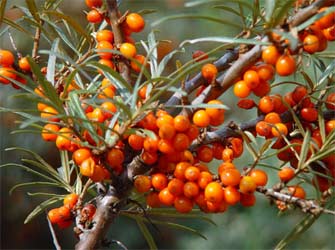 | Sea buckthorn (Hippophae rhamnoides) is one of the important natural resources of the mountainous regions of China and Russia. The plant grows naturally in sandy soil at an altitude of 1,200-4,500 meters (4,000-14,000 feet) in cold climates, though it can be cultivated at lower altitudes and into temperate zones. Recently it has been extensively planted across much of northern China, and in other countries, to prevent soil erosion and to serve as an economic resource for food and medicine products. For example, Canada has invested in planting sea buckthorn, originally brought over from Siberia in the 1930s, hoping to develop a good agriculture market; Saskatchewan has ideal growing conditions, yielding a high quality product. |
Aside from erosion control, the plant is primarily valued for its golden-orange fruits, which provide vitamin C, vitamin E, and other nutrients, flavonoids, oils rich in essential fatty acids, and other healthful components. The leaves are now also being used for making a beverage tea; they additional contain triterpenes. The following constituents are among those that have been found in the fruits:
| Constituents of Sea Buckthorn Fruit (per 100 grams fresh berries) | |
| Vitamin C | 200-1,500 mg (typical amount: 600 mg) |
| Vitamin E (mixed tocopherols) | Up to 180 mg (equal to about 270 IU) |
| Folic acid | Up to 80 mcg |
| Carotenoids, including beta carotene, lycopene, zeaxanthine; these contribute the yellow-orange-red colors of the fruit | 30-40 mg |
| Fatty acids (oils); the main unsaturated fatty acids are oleic acid (omega-9), palmitoleic acid (omega-7), palmitic acid and linoleic acid (omega-6), and linolenic acid (omega-3); there are also saturated oils and sterols (mainly β-sitosterol) | 6-11% (3-5% in fruit pulp, 8-18% in seed); fatty acid composition and total oil content vary with subspecies |
| Organic acids other than ascorbic (e.g., quinic acid, malic acid; ingredients similar to those found in cranberries) | Quantity not determined; expressed juice has pH of 2.7-3.3 |
| Flavonoids (e.g., mainly isorhamnetin, quercetin glycosides, and kaempferol; these are the same flavonoids as found in Ginkgo biloba. | 100-1,000 mg (0.1% to 1.0%) |
The flavonoids of sea buckthorn (mainly from fruit pulp; also in the leaves) and the oils of sea buckthorn (primarily in the seeds, but also in the fleshy part of the fruit) are the two items specially extracted for medicinal use. Thus, for example, a flavonoid extract product is commonly produced that contains 80% flavonoids, with 20% of residual oils, vitamin C, and other components. Sometimes the flavonoid extract is combined with an oil extract; for example, a flavonoid-oil capsule (made from flavonoid extract and oil extract blended together in a soft gelatin capsule) is produced for use in treating cardiovascular disease.
In the oil fraction, the unsaturated fatty acids are of greatest interest; extracted oils have less of the flavonoids and almost none of the vitamin C of the fruit. The oil components from several samples have been analyzed as follows:
Main Constituents of Sea Buckthorn Oils from Seed, Fruit Pulp (juice), and Fruit Residue After Removing Juice. Figures are in milligrams per 100 grams or in percent (as indicated for breakdown of fatty acid composition).
| Ingredient | Seed Oil | Pulp Oil | Fruit Residue Oil |
| Vitamin E | 207 | 171 | 300-600 |
| Vitamin K | 110-230 | 54-59 | - |
| Carotenoids | 30-250 | 300-870 | 1280-1860 |
| Total acids | 11 | 38 | - |
| Total flavonoids | - | - | 550 |
| Total sterols | 1094 | 721 | - |
| Oil Profile | |||
| Unsaturated fatty acids | 87% | 67% | 70% |
| Saturated fatty acids | 13% | 33% | 30% |
The fruit residue, which includes the outer peel, is rich in the colorful carotenoids and vitamin E; the seed has the highest level of the unsaturated fatty acids and sterols.
HEALTH APPLICATIONS
Sea buckthorn has been shown to have a potent antioxidant activity, mainly attributed to its flavonoids and vitamin C content (1). Both the flavonoids and the oils from sea buckthorn have several potential applications (2). There are five areas of research that have been focal points for their use: as an aid to patients undergoing cancer therapy; a long-term therapy for reduction of cardiovascular risk factors; treatment of gastrointestinal ulcers; internal and topical therapy for a variety of skin disorders; and as a liver protective agent (for chemical toxins) and a remedy for liver cirrhosis.
Cancer therapy: Most of the work done in this area has been with laboratory animals. A group in India headed by HC Goel (at the Department of Radiation Biology, Institute of Nuclear Medicine and Allied Sciences, in Delhi) has published several reports on the potential of a hippophae extract (an alcohol extract, which would mainly contain the flavonoids) to protect the bone marrow from damage due to radiation; his group also showed that the extract may help faster recovery of bone marrow cells (3). In China, a study was done to demonstrate faster recovery of the hemopoietic system after high dose chemotherapy (with 5-FU) in mice fed the sea buckthorn oil (4). The seed oil has been found to enhance non-specific immunity and to provide anti-tumor effects in preliminary laboratory studies (5, 6).
Cardiovascular diseases: In a double-blind clinical trial conducted in China (7), 128 patients with ischemic heart disease were given total flavonoids of sea buckthorn at 10 mg each time, three times daily, for 6 weeks. The patients had a decrease in cholesterol level and improved cardiac function; also they had less angina than those receiving the control drug. No harmful effect of sea buckthorn flavonoids was noted in renal functions or hepatic functions. The mechanism of action may include reduced stress of cardiac muscle tissue by regulation of inflammatory mediators (8). In a laboratory animal study, the flavonoids of sea buckthorn were shown to reduce the production of pathogenic thromboses (9). Some simple formulas based on sea buckthorn have been developed recently for treating cardiac disorders. For example, there is a liquid preparation of sea buckthorn flavonoids with carthamus (safflower) and licorice, called Ai Xin Bao (from the Shanxi Ai Xin Biological Technology Development Center), which is intended for use in treatment of coronary heart disease and sequelae of heart attack and stroke, through improving blood circulation and restoring cardiac function.
Gastric ulcers: Hippophae is traditionally used in the treatment of gastric ulcers, and laboratory studies confirm the efficacy of the seed oil for this application (10, 11). Its functions may be to normalize output of gastric acid and reduce inflammation by controlling pro-inflammatory mediators.
Liver cirrhosis: A clinical trial demonstrated that sea buckthorn extracts helped normalize liver enzymes, serum bile acids, and immune system markers involved in liver inflammation and degeneration (12). In addition, sea buckthorn oil protects the liver from damaging effects of toxic chemicals, as revealed in laboratory studies (13).
Skin: An ingredient of the oil, palmitoleic acid, is a component of skin. It is considered a valuable topical agent in treating burns and healing wounds. This fatty acid can also nourish the skin when taken orally if adequate quantities of sea buckthorn or its oil are consumed; this is a useful method for treating systemic skin diseases, such as atopic dermatitis (14). The only other major plant source of palmitoleic acid is macadamia nuts; the oil is used to nourish the skin. Sea buckthorn oil is already widely used alone or in various preparations topically applied for burns, scalds, ulcerations, and infections. It is an ingredient in sunblock-hippophae oil has UV-blocking activity as well as emollient properties-and it is an aid in promoting regeneration of tissues (15). The fruit may also be used for benefiting the hair: the name hippophae, means shiny horse, and refers to the good coat developed by horses feeding off the plant. SEA BUCKTHORN RESOURCE DEVELOPMENT
Sea Buckthorn has been developed into a major resource for China. The main organization overseeing and promoting its utilization is the China Research and Training Centre on Sea Buckthorn, which has given rise to the International Center for Research and Training on Sea buckthorn (ICRTS).
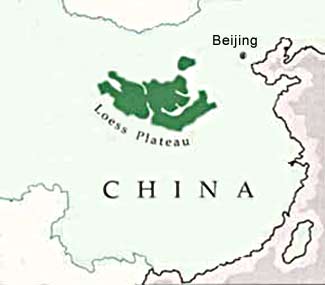 | Many northern Chinese areas have become virtually treeless, even though they were once forested. Soil losses have been huge, and several previous attempts to grow various trees to hold down the soil have been unsuccessful. Sea buckthorn has turned out to be useful because it withstands severe weather and grows huge root systems in poor soil (and fixes nitrogen in the soil). Its planting and maintenance is encouraged by the local people who can earn income from harvesting the fruits (and other parts of the plant). It was noted by ICRTS that in the Loess Plateau of northern China (see map), annual topsoil losses are about 1,600 million tons. Downstream effects include an annual accumulation in the Yellow River of 400 million tons of sediments. Sea buckthorn now covers more than 200,000 hectares (500,000 acres) in the Loess Plateau. Of 360 bird species known to live in the region, 51 entirely depend on sea buckthorn as food and 80 are relatively dependent upon sea buckthorn. For many of the other animal species, sea buckthorn is an important source of food or provides shelter. The leaves and tender branches are a rich source of protein (11-22% by weight). |
A similar project was successfully developed in Mongolia where former attempts to use astragalus as the economic plant to stabilize the soil failed, while hippophae succeeded. Having confirmed that sea buckthorn was the most competitive species for the purpose of controlling water losses and soil erosion, a total of 67,000 hectares (166,000 acres) of sea buckthorn forest were planted in Jianping County of Liaoning Province. This helped to increase the vegetation cover from 4% in the 1950s to 34% in the 1990s. Run-off was reduced by 90% and soil erosion declined by 70%. Fodder, fuel wood, and berries contribute to local economic development (up to 3 tons of fresh berries can be collected on every acre of sea buckthorn forest). Several wild animal species have found a habitat in the sea buckthorn forest, including pheasant, hare, and fox. Altogether, China now has over 1.5 million hectares of sea buckthorn, 40% of it natural, the rest planted. There are over 200 processing plants for sea buckthorn in China. | 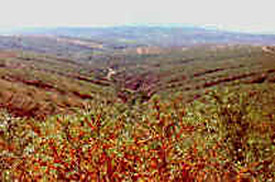 |
MANUFACTURE OF SEA BUCKTHORN PRODUCTS
Following is a diagram of a processing method that can be used to separate useful components of the berries, yielding the key products of juice, dried fruit nutrients, and oil from the seeds and pulp; residues can be utilized as valuable animal feed. New technologies, involving supercritical carbon dioxide extraction, are now being used in China to efficiently produce the oil products.
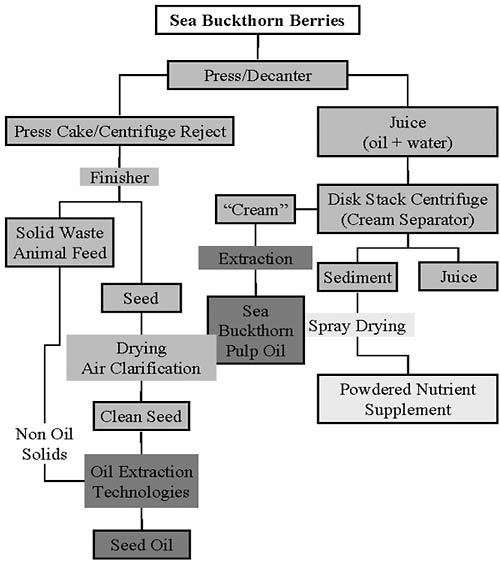
By Subhuti Dharmananda, Ph.D., Director, Institute for Traditional Medicine, Portland, OR

SEA BUCKTHORN PRODUCTS
There are several sea buckthorn products on the market already. Examples are displayed below.
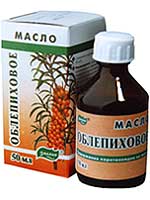 Russian sea buckthorn oil in Russian packaging | 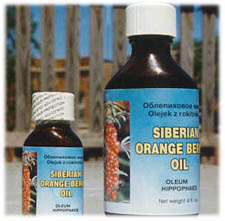 Russian sea buckthorn oil in English packaging | 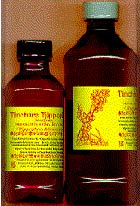 Sea buckthorn tincture |
 Sea buckthorn lip balm | 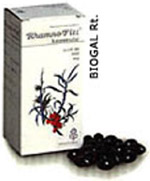 Rhamno-fitt, an encapsulated buckthorn oil extract | 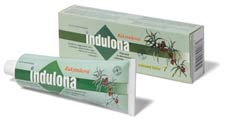 Indulona, a topical cream |
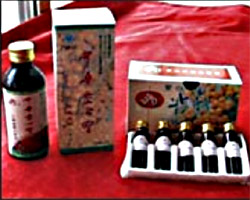 oral liquid with carthamus flower and licorice | 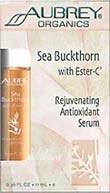 Aubrey Organics antioxidant serum | 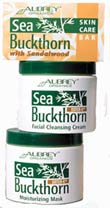 Aubrey Organics skin care products |
1 comment:
Loved your article on natural supplements. Sea Buckthorn benefits not only support digestion but also helps to maintain healthy cholesterol levels. I can tell you’ve put a lot of effort into making this content valuable.
Post a Comment